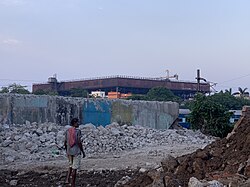Tala, Kolkata
Tala | |
|---|---|
Neighbourhood in Kolkata (Calcutta) | |
 Tala Water Tank | |
| Coordinates: 22°36′43″N 88°22′54″E / 22.611889°N 88.381694°E | |
| Country | |
| State | West Bengal |
| City | Kolkata |
| District | Kolkata |
| Metro Station | Shyambazar and Belgachia |
| Municipal Corporation | Kolkata Municipal Corporation |
| KMC ward | 5 |
| Population | |
• Total | For population see linked KMC ward pages |
| Time zone | UTC+5:30 (IST) |
| PIN | 700037 |
| Area code | +91 33 |
| Lok Sabha constituency | Kolkata Uttar |
| Vidhan Sabha constituency | Kashipur-Belgachhia |
Tala is a neighbourhood in North Kolkata in Kolkata district in the Indian state of West Bengal.
History
The East India Company obtained from the Mughal emperor Farrukhsiyar, in 1717, the right to rent from 38 villages surrounding their settlement. Of these 5 lay across the Hooghly in what is now Howrah district. The remaining 33 villages were on the Calcutta side. After the fall of Siraj-ud-daulah, the last independent Nawab of Bengal, it purchased these villages in 1758 from Mir Jafar and reorganised them. These villages were known en-bloc as Dihi Panchannagram and Tala was one of them. It was considered to be a suburb beyond the limits of the Maratha Ditch.[1][2][3]
Geography

Tala is adjacent to Shyambazar and Belgachia. Barrackpore Trunk Road passes on the western boundary of Tala. Tala railway station on Kolkata Circular Railway line serves the locality. Kolkata Station, one of the major railway hub stations of the city, is also located nearby.
Police district
Tala police station is part of the North and North Suburban division of Kolkata Police. Located at 4, Indra Biswas Road, Kolkata-700037, it has jurisdiction over Tala, Paikpara and Belgachia neighbourhoods/ Ward nos. 3, 4 and 5 of Kolkata Municipal Corporation.[4][5]
Amherst Street Women police station covers all police districts under the jurisdiction of the North and North Suburban division i.e. Amherst Street, Jorabagan, Shyampukur, Cossipore, Chitpur, Sinthi, Burtolla and Tala.[4]
Tala water tank
Tala water tank of Kolkata Municipal Corporation was built in 1909. It has the capacity to hold 9 million gallons of water and is the largest overhead reservoir in the world. It has a height of 110 feet.[6][7]
References
- ^ "District Census Handbook Kolkata, Census of India 2011, Series 20, Part XII A" (PDF). Pages 6-10: The History. Directorate of Census Operations, West Bengal. Retrieved 20 February 2018.
- ^ Cotton, H.E.A., Calcutta Old and New, first published 1909/reprint 1980, pages 103-4 and 221, General Printers and Publishers Pvt. Ltd.
- ^ Nair, P.Thankappan, The Growth and Development of Old Calcutta, in Calcutta, the Living City, Vol. I, pp. 14-15, Edited by Sukanta Chaudhuri, Oxford University Press, 1995 edition.
- ^ a b "Kolkata Police". North and North Suburban Division. KP. Retrieved 5 March 2018.
- ^ Kolkata: Detail Maps of 141 Wards with Street Directory, Fourth Impression 2003, Map Nos. 2 and 3, D.P.publication and Sales Concern, 66 College Street, Kolkata - 700 073.
- ^ "Tala water tank to be revamped for 1st time". Asian Age, 24 April 2017. Retrieved 8 March 2018.
- ^ "Kolkata Municipal Corporation". Water Supply. Retrieved 8 March 2018.
External links
![]() Kolkata/Northern fringes travel guide from Wikivoyage
Kolkata/Northern fringes travel guide from Wikivoyage
